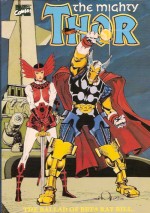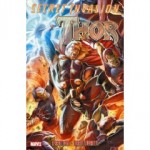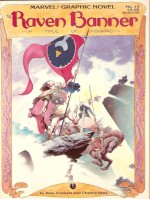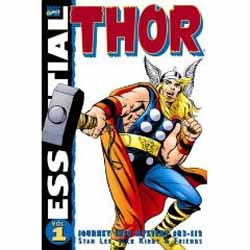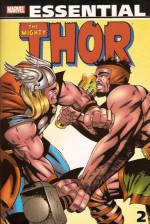
By Stan Lee, Jack Kirby, & various (Marvel)
ISBN: 978-0-7851-3381-0
Even more than the Fantastic Four The Mighty Thor was the arena in which Jack Kirby’s creative brilliance blended with his questing exploration of an Infinite Imaginative Cosmos: dreaming, extrapolating and honing a dazzling new kind of storytelling graphics with soul-searching, mind-boggling concepts of Man’s place in the universe.
His unforgettable string of pantheons began in a modest little fantasy title called Journey into Mystery where, in the summer of 1962 a tried-and-true comicbook concept (feeble mortal transformed into God-like hero) was employed by the fledgling Marvel Comics to add a Superman analogue to their growing roster of costumed adventurers. This gloriously economical monochrome tome re-presents the end of that catch-all title as the Asgardian’s increasingly popular exploits saw the title become The Mighty Thor.
Gathered here are Journey into Mystery issues #113-125 plus the Annual for 1965, and without breaking stride, Thor #126-136 and the 1966 Annual, all in clean, crisp black and white for your delectation.
Lonely, crippled American doctor Donald Blake took a vacation in Norway only to encounter the vanguard of an alien invasion. Trapped in a cave, Blake found a gnarled old walking stick, which when struck against the ground turned him into the Norse God of Thunder!
Within moments he was defending the weak and smiting the wicked. As the months swiftly passed the rapacious extraterrestrials, Commie dictators, costumed crazies and cheap thugs gradually gave way to a vast panoply of fantastic worlds and incredible, mythic menaces. By issue #113, the magnificent warrior’s world of Asgard was a regular milieu for the hero’s adventures, and in ‘A World Gone Mad!’ by Stan Lee, Kirby and Chic Stone, the Thunderer, after saving the Shining Realm from invasion, once more defied his father Odin to romantically pursue the mortal nurse Jane Foster – a task made rather hazardous by the return of the petrifying villain Grey Gargoyle.
A long-running plot strand – almost interminably so – was the soap-opera tangle caused by Don Blake’s love for his nurse – a passion his alter ego shared. Sadly the Overlord of Asgard refused to allow his son to love a mortal, which acrimonious triangle provided many attempts to humanise and de-power Thor, already a hero few villains could cope with.
These issues also carried a spectacular back-up series. Tales of Asgard – Home of the mighty Norse Gods gave Kirby space to indulge his fascination with legends and allowed both complete vignettes and longer epics (in every sense of the word). Initially adapted myths, these little yarns grew into sagas unique to the Marvel universe where Kirby built his own cosmos and mythology, underpinning the company’s entire continuity. Here he revealed ‘The Boyhood of Loki!’, scripted as ever by Lee and inked by Vince Colletta, a pensive, brooding taste of the villain to be.
JiM # 114, began a two-part tale that introduced a new villain of the sort Kirby excelled at, a vicious thug who suddenly lucked into overwhelming power. ‘The Stronger I Am, The Sooner I Die!’(Lee, Kirby & Stone) saw Loki imbue hardened felon Crusher Creel with the power to duplicate the strength and attributes of anything he touched, but before he was treated to ‘The Vengeance of the Thunder God’ (inked by Frank Giacoia as the pseudonymous Frankie Ray) we’re indulged with another Tale of Asgard – ‘The Golden Apples.’ Issue #115’s mini-myth was ‘A Viper in our Midst!’ with young Loki clandestinely cementing relations with the sinister Storm Giants – sworn enemies of the Gods.
A longer saga began in #116, as Colletta settled in as the regular inker for both lead and second feature. ‘The Trial of the Gods’ revealed more of fabled Asgard as Thor and Loki underwent a Trial by Combat, with the god of mischief cheating at every step, whilst ‘Into the Blaze of Battle!’ found Balder the Brave protecting Jane Foster whilst her godly paramour travelled to war-torn Vietnam seeking proof of his step-brother’s infamy. These tales were supplemented by the stellar novellas ‘The Challenge!’ and ‘The Sword in the Scabbard!‘ which saw Asgardian cabin-fever develop into a quest to destroy a threat to the mystic Odinsword, which unsheathing would destroy the universe…
Journey into Mystery #118’s ‘To Kill a Thunder God!’ ramped up the otherworldly drama as Loki, attempting to cover his tracks, unleashed an ancient Asgardian WMD – the Destroyer. When it damaged the mystic hammer of Thor and nearly killed the hero in ‘The Day of the Destroyer!’, the God of Mischief was forced to save his step-brother or bear the brunt of Odin’s anger. Meanwhile in Tales of Asgard the Quest further unfolded in ‘The Crimson Hand!’ and ‘Gather, Warriors!’ as a band of hand-picked Argonauts joined Thor’s flying longship in a bold attempt to forestall Ragnarok.
With the Destroyer defeated and Loki temporarily thwarted Thor returned to America ‘With My Hammer in Hand…!’ only to clash once more with the awesome Absorbing Man. However before that bombastic battle there’s not only the next instalment of the Asgardian Argonauts who boldly ‘Set Sail!’ but also the admittedly superb digression of Journey into Mystery Annual #1, wherein the God of Thunder fell into the realm of the Greek Gods for the landmark heroic hullabaloo ‘When Titan’s Clash! Thor vs. Hercules!’ This incredible action-epic is augmented here by a beautiful double-page pin-up of downtown Asgard – a truly staggering piece of Kirby magic.
The attack of the Absorbing Man resumed with ‘The Power! The Passion! The Pride!’ and seemed set to see the end of Thor: a cliffhanger somewhat assuaged by ‘Maelstrom!’ wherein the Argonauts of Asgard epically encountered an uncanny storm… In JiM #122 ‘Where Mortals Fear to Tread!’ the triumphant Crusher Creel was shanghaied by Loki to attack Asgard and Odin himself, an incredible clash that led to a cataclysmic conclusion ‘While a Universe Trembles!’ Meanwhile ‘The Grim Specter of Mutiny!’ invoked by seditious Loki was quashed in time for valiant Balder to save the Argonauts from ‘The Jaws of the Dragon!’ in the increasingly spectacular Ragnarok Quest.
With the threat to ended Thor returned to Earth to defeat the Demon, a witchdoctor empowered by a magical Asgardian Norn Stone left behind after the Thunder God’s Vietnamese venture. Whilst he was away Hercules was dispatched to Earth on a reconnaissance mission for Zeus. ‘The Grandeur and the Glory!’ began another extended story-arc and all-out action extravaganza, which bounced the Thunderer from bruising battle to brutal defeat to ascendant triumph.
Issue #125 ‘When Meet the Immortals!’ was the last Journey into Mystery: with ‘Whom the Gods Would Destroy!’ the comic was re-titled The Mighty Thor and the drama escalated unabated, culminating with ‘The Hammer and the Holocaust!’ In short order Thor crushed the Demon, seemingly lost his beloved Jane to Hercules, was deprived of his powers and subsequently thrashed by the Grecian Prince of Power but still managed to save Asgard from an unscrupulous traitor who had usurped Odin’s mystic might.
Meanwhile in the Tales of Asgard instalments the Questers homed in on the cause of all their woes. ‘Closer Comes the Swarm’ pitted them against the flying trolls of Thryheim, and ‘The Queen Commands’ saw Loki captured until Thor answered ‘The Summons!’, promptly returning the Argonauts to Asgard to be shown ‘The Meaning of Ragnarok!’
In all honestly these mini-eddas were, although still magnificent in visual excitement, becoming rather rambling in plot, so the narrative reset was neither unexpected nor unwelcome…
Instead of ending, the grandiose saga actually grew in scope with Thor #128 as ‘The Power of Pluto!’ introduced another major foe. The Greek God of the Underworld had tricked Hercules into replacing him in his dread, dead domain, just as the recuperated Thunder God was looking for a rematch, whilst in Tales of Asgard Kirby pulled out all the creative stops to depict the ‘Aftermath!’ of Ragnarok: for many fans the first indication of what was to come in the King’s landmark Fourth World tales half a decade later…
‘The Verdict of Zeus!’ condemned Hercules to the underworld unless he could find a proxy to fight for him, whilst at the back of the comic the assembled Asgardians faced ‘The Hordes of Harokin’ as another multi-chaptered classic began, but for once the cosmic scope of the lead feature eclipsed the little odysseys as ‘Thunder in the Netherworld!’ saw Thor and Hercules carve a swathe of destruction through an unbelievably alien landscape – the beginning of a gradual side-lining of Earthly matters and mere crime-fighting. Thor and Kirby were increasingly expending their efforts in greater realms than ours…
‘The Fateful Change!’ saw the younger Thunder God trade places with the Geghiz Khan-like Harrokin, whilst in issue #136, Thor defeated the invasion plans of Rigellian Colonizer Tana Nile in ‘They Strike from Space!’, but it was merely prologue for a fantastic voyage to the depths of space and a unique universal threat, whilst “Harokin†faced a dire dilemma in ‘The Warlock’s Eye!’.
Thor #132 found the Thunderer laying down the law on ‘Rigel: Where Gods May Fear to Tread!’ whilst ‘The Dark Horse of Death!’ arrived in the Tales of Asgard segment looking for its next doomed rider… The following issue is a Kirby Classic, as ‘Behold… the Living Planet!’ introduced the malevolent Ego, sentient world and master of the living Bio-verse, a stunning visual tour de force that threw one High Concept after another at Thor, his new artificial pal Recorder and the reeling readership, whilst Harokin’s saga ended in one last ride to ‘Valhalla!’
The threat of invasion over, Thor returned to Earth to search for Jane, finding her with ‘The People Breeders!’ – a hidden enclave where the geneticist High Evolutionary was instantly evolving animals into men. His latest experiment had created a lupine future-nightmare ‘The Maddening Menace of the Super-Beast!’ so it’s just as well the Thunder God was on hand. ‘When Speaks the Dragon!’ and ‘The Fiery Breath of Fafnir!’ pitted Thor and his Warriors Three comrades Fandral, Hogun and Volstagg against a staggering reptilian monstrosity: a threat finally quashed in #136’s ‘There Shall Come a Miracle!’
The lead story in that issue is a turning point in the history of Thor. ‘To Become an Immortal!’ saw Odin transform Jane Foster into a Goddess and emigrate to Asgard, but her frail human mind could not cope with the wonders and perils of the Realm Eternal and she was mercifully restored to mortality and all but written out of the series. Lucky for the despondent Thunder God the beauteous Warrior-Maiden Sif was on hand…
With this story Thor’s closest link to Earth was neatly severed: from now on his many adventures on Midgard were as a tourist or beneficent guest, not a resident. Asgard and infinity were now his true home, a situation quickly proved by the bombastic clash that closes this volume. ‘If Asgard Falls…’ is set in the Gleaming City during the annual Tourney of Heroes (and comes from The Mighty Thor Annual #2, 1966): a martial spectacular of outlandish armours and exotic weaponry that turned decidedly serious when the deadly Destroyer was unleashed amidst the wildly warring warriors…
These transitional Thor tales show the development not only of one of Marvel’s fundamental continuity concepts but more importantly the creative evolution of the greatest imagination in comics. Set your commonsense on pause and simply wallow in the glorious imagery and power of these classic adventures for the true secret of what makes graphic narrative a unique experience.
© 1965, 1966, 1967, 2008 Marvel Characters, Inc. All Rights Reserved.

